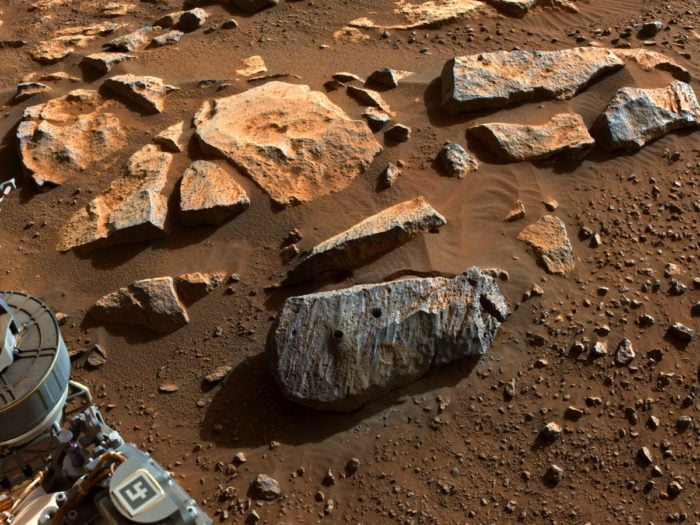
NASA’s Perseverance rover collected its first pair of rock samples, with scientists already seeing proof that water existed on Mars.
After collecting its first sample, named “Montdenier,” on September 6, the NASA team collected a second, “Montagnac,” from the same rock on September 8.
Analysis of the rocks from which the Montdenier and Montagnac samples were taken and from previous sampling attempt may help the science team map the planet’s past.
The rock samples show NASA‘s scientists that Mars had persistent water and was marked by volcanic activity.
Water on Mars
The water on Mars seems to have existed for a long time, the scientists have found.
“It looks like our first rocks reveal a potentially habitable sustained environment,” said Ken Farley of Caltech, project scientist for the mission, which is led by NASA’s Jet Propulsion Laboratory in Southern California.
“It’s a big deal that the water was there a long time,” Farley said.
The rock that provided the mission’s first core samples is basaltic in composition and may be the product of lava flows.
The presence of crystalline minerals in volcanic rocks is especially helpful in radiometric dating. The volcanic origin of the rock could help scientists accurately date when it formed.
Each rock sample can serve as part of a larger chronological puzzle. If they are put in the right order, they can show a timeline of the most important events in the crater’s history.
Some of those events include the formation of Jezero Crater, the emergence and disappearance of Jezero’s lake, and changes to the planet’s climate in the ancient past.
Salts found in the rocks
Within the rocks, scientists found salts. These salts may have formed when groundwater flowed through and altered the original minerals in the rock, or more likely when liquid water evaporated, leaving the salts.
The salt minerals in these first two rock cores may also have trapped tiny bubbles of ancient Martian water. If so, they could offer information about the ancient climate and habitability of Mars.
On Earth, salt minerals have shown their ability to preserve signs of ancient life.
The Perseverance science team already knew a lake once filled the crater. However, they don’t know for how long.
The scientists couldn’t dismiss the possibility that Jezero’s lake was a “flash in the pan”: Floodwaters could have rapidly filled the impact crater and dried up in the space of 50 years, for example.
Yet, the level of alteration that scientists see in the rock samples suggests that ground water was present for a long time on Mars.
This groundwater could have been related to the lake that was once in Jezero, or it could have traveled through the rocks long after the lake had dried up.
The scientists are not certain how long the water that altered these rocks was present on Mars. Yet, now they are more certain it was present for long enough to make the area more welcoming to microscopic life in the past.
“These samples have high value for future laboratory analysis back on Earth,” said Mitch Schulte, the mission’s program scientist.
“One day, we may be able to work out the sequence and timing of the environmental conditions that this rock’s minerals represent. This will help answer the big-picture science question of the history and stability of liquid water on Mars.”
Source: NASA
See all the latest news from Greece and the world at Greekreporter.com. Contact our newsroom to report an update or send your story, photos and videos. Follow GR on Google News and subscribe here to our daily email!



